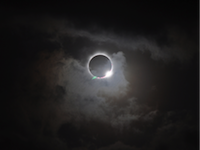

The-CNN-Wire ™ & © 2021 Cable News Network, Inc., a WarnerMedia Company. "And now we're getting into that region and hopefully going to start seeing some of these physics and behaviors." "It is a really important region to get into because we think all sorts of physics potentially turn on," Kasper said. This means that the outer edge of the sun's corona will expand and Parker will likely get to spend more time flying through the sun's mysterious outer atmosphere. The newest solar cycle, which began in December 2019, has been predicted to peak in July 2025, which means an increase in solar activity. It's important to understand the solar cycle because space weather caused by the sun - eruptions like solar flares and coronal mass ejection events - can impact the power grid, satellites, GPS, airlines, rockets and astronauts in space. Every 11 years, the sun completes a solar cycle of calm and stormy activity and begins a new one. Parker is likely to be in the right place at the right time during future flybys as the sun's 11-year cycle heats up with activity over the next few years. "The opportunity for new discoveries is boundless."

"I'm excited to see what Parker finds as it repeatedly passes through the corona in the years to come," said Nicola Fox, division director for NASA's Heliophysics Division, in a statement. The spacecraft will likely fly through the corona again in January during its next flyby. In this case, particles moved slower and the zig-zagging switchbacks decreased. Typically, Parker is bombarded with particles as it flies through the solar wind. When the spacecraft flew through the pseudostreamer, things were quiet, just like in the eye of a storm.

It passed through a feature called a pseudostreamer, a large structure rising above the surface of the sun that has been observed from Earth during solar eclipses. Understanding the presence of these features could allow scientists to match them with solar activity from the sun's surface.ĭuring the flyby, Parker made another intriguing encounter as it passed 6.5 million miles from the sun's surface. Parker wove in and out of the corona several times over the course of a few hours during the April flyby, which helped researchers understand that the boundary, called the Alfvén critical surface, isn't a smooth circle around the sun. "It is very exciting that we've already reached it." "We were fully expecting that, sooner or later, we would encounter the corona for at least a short duration of time," said Justin Kasper, lead study author, University of Michigan professor and deputy chief technology officer at BWX Technologies, Inc. It occurred when the spacecraft made its eighth flyby of the sun and registered magnetic and particle conditions specific to a boundary where the sun's massive solar atmosphere ends and the solar wind begins - 8.1 million miles above the surface of the sun. In April, the Parker team realized their spacecraft had crossed the boundary and entered the solar atmosphere for the first time. Scientists, including the spacecraft's namesake astrophysicist Eugene Parker, want to answer fundamental questions about the solar wind that streams out from the sun, flinging energetic particles across the solar system. The Parker Solar Probe launched in 2018 and set out to circle closer and closer to the sun. The announcement was made at the 2021 American Geophysical Union Fall Meeting in New Orleans on Tuesday, and research from the solar milestone has been published in the Physical Review Letters. "Not only does this milestone provide us with deeper insights into our Sun's evolution and (its) impacts on our solar system, but everything we learn about our own star also teaches us more about stars in the rest of the universe." "Parker Solar Probe 'touching the Sun' is a monumental moment for solar science and a truly remarkable feat," said Thomas Zurbuchen, the associate administrator for NASA's Science Mission Directorate, in a statement. Sixty years after NASA set the goal, and three years after its Parker Solar Probe launched, the spacecraft has become the first to "touch the sun." The Parker Solar Probe has successfully flown through the sun's corona, or upper atmosphere, to sample particles and our star's magnetic fields. Sixty years after NASA set the goal, and three years after its Parker Solar Probe launched, the spacecraft has become the first to "touch the sun."ĬAPE CANAVERAL, Fla.


 0 kommentar(er)
0 kommentar(er)
